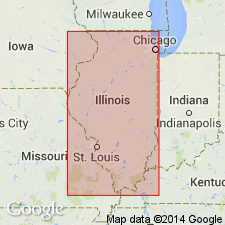
- Usage in publication:
-
- Arsenal Member
- Modifications:
-
- Original reference
- Dominant lithology:
-
- Chert
- AAPG geologic province:
-
- Wisconsin arch
Summary:
Pg. 43 (fig. 15), 45. Arsenal Member of Oneota Dolomite. Name proposed for basal cherty unit of Oneota. Thickness 100 to 150 feet. Underlies Blodgett Member (new); overlies Gunter Sandstone. Age is Ordovician.
Type section (subsurface): depth-interval 980 to 1,085 ft, Layne-Western Kankakee No. 9 well, sec. 25, T. 34 N., R. 9 E., Will Co., northeastern IL. Named from Joliet Arsenal in western Will Co.
Source: US geologic names lexicon (USGS Bull. 1350, p. 32).

- Usage in publication:
-
- Arsenal Member
- Modifications:
-
- Overview
- AAPG geologic province:
-
- Wisconsin arch
Summary:
Pg. 53 (fig. O-4), 55. Arsenal Member of Oneota Dolomite of Praire du Chien Group. Recognized in northeastern quarter of state. Consists of light gray, medium-grained, cherty to very cherty dolomite. Thin shale partings common near base. Thickness 90 to about 200 feet. Is lower member of Oneota Dolomite; underlies Blodgett Member. Overlies Gunter Sandstone of Prairie du Chien Group. Age is Early Ordovician (Canadian).
Source: Publication.
For more information, please contact Nancy Stamm, Geologic Names Committee Secretary.
Asterisk (*) indicates published by U.S. Geological Survey authors.
"No current usage" (†) implies that a name has been abandoned or has fallen into disuse. Former usage and, if known, replacement name given in parentheses ( ).
Slash (/) indicates name conflicts with nomenclatural guidelines (CSN, 1933; ACSN, 1961, 1970; NACSN, 1983, 2005, 2021). May be explained within brackets ([ ]).

